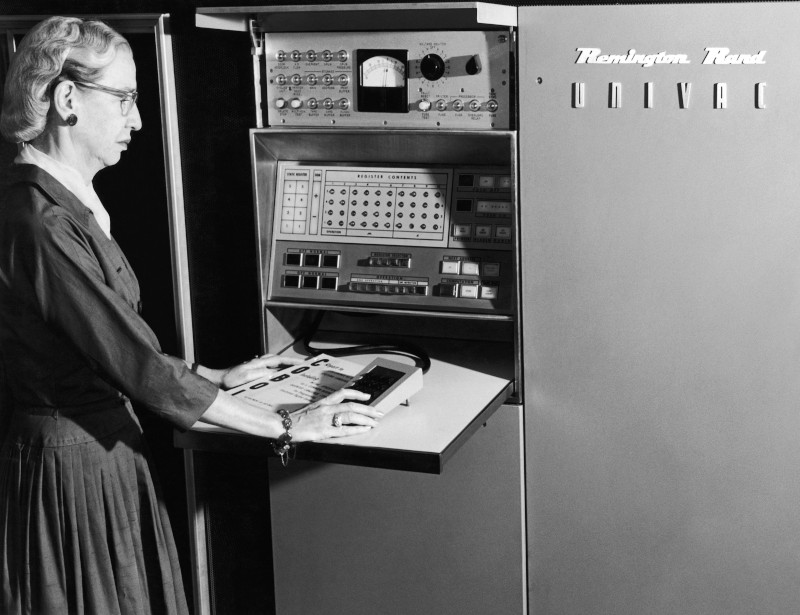Rear Admiral Grace Murray Hopper ’28“Queen of Code” Earns Posthumous Honors, Continues to Open Doors for Women in Tech
Rear Admiral Grace Murray Hopper ’28“Queen of Code” Earns Posthumous Honors, Continues to Open Doors for Women in Tech
As a programmer of the world’s first digital computer in the 1940s, Grace Murray Hopper saw what her colleagues didn’t: that the full potential of these amazing machines would never be realized if only mathematicians like herself could use them. So, in the 1950s, she invented the compiler—a program that translates English-language instructions into computer code. The world has never looked back.

As one of the world’s first computer scientists, Grace Murray Hopper ’28 worked on the UNIVAC computer series and developed the programming language COBOL.
Hopper’s remarkable legacy has brought her honors and accolades long after her passing in 1992. In 2017, Yale University renamed a residential college in her honor. While seeking a suitable honoree to replace the previous namesake (John C. Calhoun, a 19th-century white supremacist and slavery promoter), Hopper’s name was suggested more than any other.
“Grace Hopper was constantly imagining new problems for the computer to solve—new ways to use the enormous capabilities she envisioned for it,” noted Yale President Peter Salovey at the dedication ceremony. “Many people told her that computers could never do what she wanted them to do. It turns out, they were wrong.”
Grace Brewster Murray was born in New York City in 1906. She fell in love with math at an early age and was encouraged to pursue her interests in a way that she called “unusual” for the times. “I was very fortunate in that my father believed his daughters should be given the same opportunities as his son, so my sister and I both went to Vassar,” she said in a recorded oral history.
The future “Queen of Code” majored in mathematics while her sister, Mary Murray Westcote ’30, majored in economics. After graduating in 1928 with honors in math and physics, Hopper earned a master’s degree in mathematics at Yale on a Vassar fellowship. She returned to Vassar with her new husband, Vincent Foster Hopper, in 1931 to join the mathematics faculty. In the course of her 13 years in Poughkeepsie, she earned a PhD from Yale in absentia.
When World War II broke out, Hopper immediately tried to volunteer for service in the U.S. Navy. The diminutive mathematician was rejected from the WAVES (Women Accepted for Voluntary Emergency Service) in 1942 for not weighing enough, but was accepted the following year.
“I’d had a grandfather who was a rear admiral and I would have loved to have been in the Navy from the beginning, but at the time when I was growing up, they didn’t take women,” Hopper recalled in her oral history. “The Navy assigned me to the Bureau of Ordnance Computation Project and sent me to Harvard to work on the first computer in the United States, the Mark I. Nobody knew anything about computers then. That was the first one.”
After the war, she left active service and moved into the private sector, joining the Eckert-Mauchly Corporation—which later became Remington Rand and then Sperry Rand. There, Hopper worked on UNIVAC, the first commercial large-scale electronic computer. In 1952, she invented the compiler.
“It’s much easier for most people to write an English statement than it is to use symbols,” she later explained. “So I decided data processors ought to be able to write their programs in English, and the computers would translate them into machine code. That was the beginning of COBOL (common business-oriented language), a computer language for data processors.”
Meanwhile, Hopper maintained her ties with the Navy and academia. “The most important thing I’ve accomplished, other than building the compiler, is training young people,” she said. “I keep track of them as they get older, and I stir ’em up at intervals so they don’t forget to take chances.”

In 1966, age restrictions forced Hopper to retire from the Naval Reserves, but that didn’t last: She was called to active duty the very next year at the age of 60 to direct the Navy’s standardization of COBOL and eventually became one of the few women ever to achieve the rank of rear admiral. When she retired in 1986 at age 79, Hopper was the oldest-serving officer in the U.S. armed forces.
Upon her death in 1992 at the age of 85, Grace Murray Hopper was buried with full Naval honors at Arlington National Cemetery. In 1997, the Navy commissioned the USS Hopper—a high-tech destroyer called “Amazing Grace” by its crew. And in November 2016, President Barack Obama posthumously awarded Hopper the Presidential Medal of Freedom. Each year, the Anita Borg Institute holds the world’s largest conference for women in technology. It’s called the Grace Hopper Celebration, and a contingent of Vassar students always makes the trip—to get stirred up.
Professor of Computer Science Jennifer Walter, who has taken more than 100 Vassar students to the conference since 2006, said for many the experience is “life changing” because of opportunities that arise for these young women on the spot.
“One female Vassar student I remember particularly well had a dream of working in the gaming industry, a notoriously male-dominated group that is rumored to hire only the top programmers,” she said. “Her dream came true when she was hired right after graduation into her dream job at a gaming company that had interviewed her at a Grace Hopper conference. And there are so many similar success stories.”